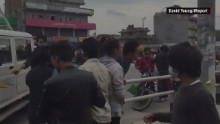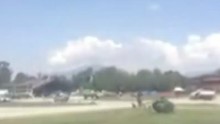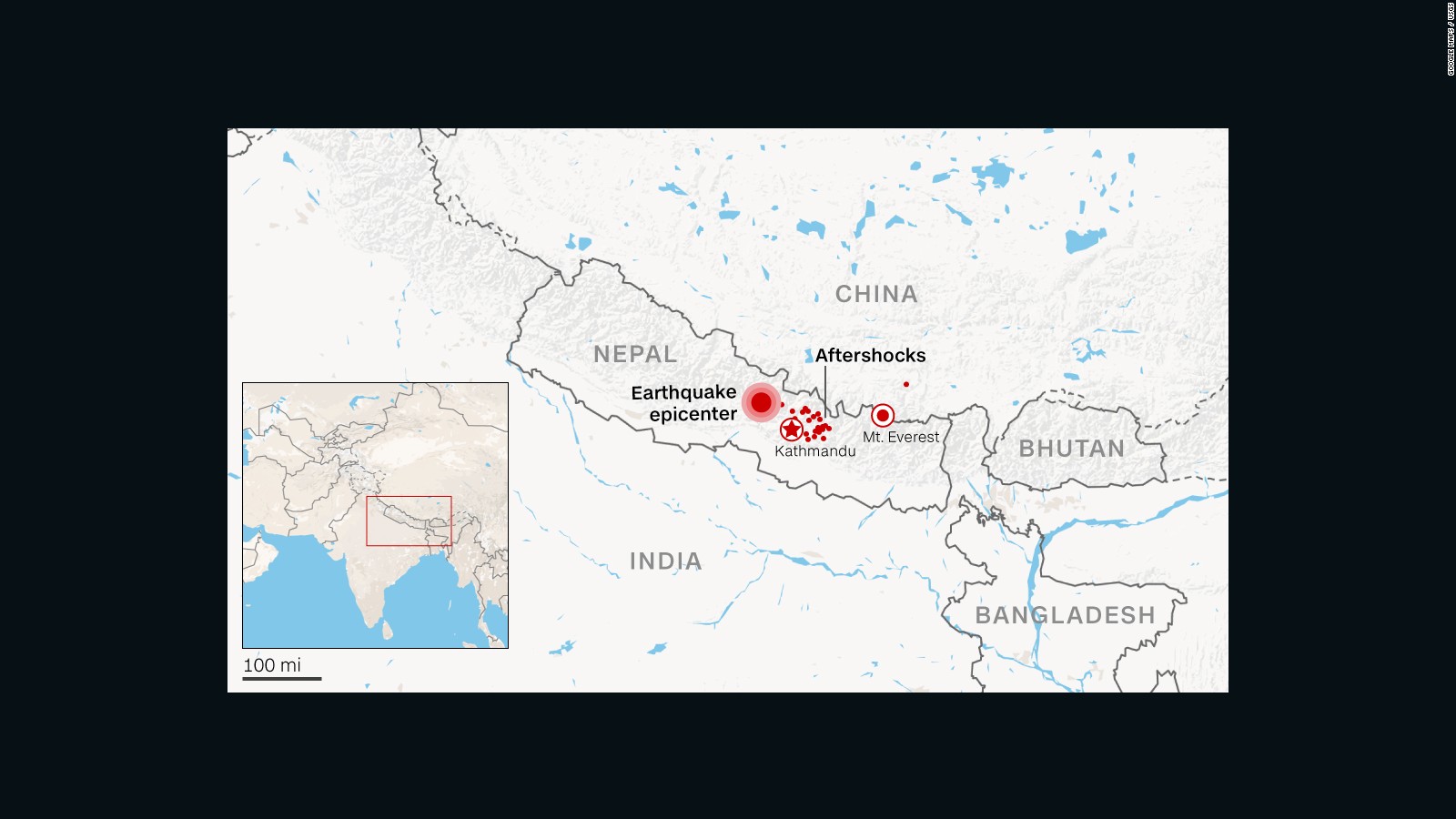Nepal earthquake homeless urgently need tents; death toll above 5,200
Source: CNN
Story highlights
- U.N. children's agency says 1.7 million children are in urgent need of aid in Nepal
- Death toll in Nepal stands at 5,238, officials say; casualties in India and China, too
- Nepal needs 500,000 tents for those made homeless by the quake, minister says
Kathmandu, Nepal (CNN)Half a million tents are urgently needed for the huge number of people forced from their homes by Nepal's devastating earthquake, a government minister said Wednesday, as rescue efforts continue in the stricken nation.
Minendra Rijal, Nepal's minister of information and communications, said relief operations were underway, but that much more needs to be done.
"Life is returning to normal, but it will be some time to be completely normal," he said. "We have still not been able to properly manage to provide relief."
Rijal wasn't able to put a precise number on those made homeless by Saturday's devastating quake.
But he said the government had so far provided more than 4,700 tents and 22,000 tarpaulins to those in need of shelter. Aircraft loaded with tents are expected from India and Thailand in the next day, he said, with another 100,000 tents expected from Pakistan.
The United Nations has said the quake has affected 8 million people across 39 districts, with a quarter of those in the worst affected areas.
Rijal said 21 helicopters, including seven provided by India, were helping in the rescue and relief efforts, with 866 people rescued by air and a little more than 1,000 rescued using land transport.
As rescue workers seek to reach people who desperately need help, the weather is only making things worse.
Heavy rain has intensified the hardships for the countless Nepalis who are sleeping out in the open because their homes were destroyed or they don't feel safe inside buildings amid continuing aftershocks.
U.N. children's agency UNICEF said Wednesday that 1.7 million children are now in urgent need of aid in the areas worst-hit by the earthquake as it launched a $50 million appeal to get help to them.
"The lives of so many children have been torn apart and they are in desperate need of life-saving support, including clean water, shelter and sanitation," said Tomoo Hozumi, the agency's Nepal representative.
"Without a safe water supply, waterborne diseases remain huge risks for children. Many families are struggling simply to protect themselves from the sun and rain, and we only expect needs to grow in the coming days."
Vital supplies
In the district of Gorkha, where the 7.8-magnitude quake was centered, a large storm rumbled over the mountainous terrain Tuesday afternoon.

Man pulled from earthquake rubble in Nepal after 80 hours01:04
"That essentially shut down helicopter missions for the entire afternoon, except for a small window before sunset," Matt Darvas, an emergency communications officer for the humanitarian group World Vision, told CNN on Wednesday. He's currently in the main town in Gorkha.
The canceled helicopter flights meant fewer airdrops of vital supplies to devastated villages and dashed hopes of rescues for injured people in isolated locations.
There was brighter news from the outskirts of the capital, Kathmandu, however, where rescuers pulled a man from the wreckage of a building where he had been stuck for a staggering 80 hours.
Makeshift field hospital
Some 5,238 people were confirmed dead as of Wednesday evening as a result of the massive earthquake, with another 10,348 injured, Nepal's National Emergency Coordination Center told CNN. Officials have warned the death toll is expected to rise.
Two neighboring countries, India and China, have reported totals of 72 and 25 deaths from the quake, respectively.
Powerful earthquake hits Nepal 55 photos
The frequent downpours in Nepal have made it harder for emergency workers to help the injured.
CNN's Dr. Sanjay Gupta was at an army field hospital in Kathmandu when the heavens opened Tuesday.
"The rain has arrived and in many cases this is the worst-case scenario," he said. "This is what they were hoping wouldn't happen."
Pieces of tape held patches in the ceiling as water threatened to bubble in; sheets of canvas served as walls.
Gupta said it was "kind of remarkable what they've been able to do" at the makeshift hospital. Over three days, the medical staff there had treated 617 patients and saved 586 of them.
Monsoon looms
The rain has also increased the risk of landslides and mudslides across rugged terrain already destabilized by the earthquake's tremors.

CNN embeds with Nepalese military to survey destruction 02:52
Two landslides were reported Tuesday afternoon in the Langtang region, a popular trekking area north of Kathmandu. As many as 200 people were feared to be missing in each of the landslides, officials said.
Foreigners are among the missing from one of them, said Gautam Rimal, a senior official in Rasuwa district. He said 210 people had been rescued from the area Wednesday by government helicopters.
Peter Bodde, U.S. ambassador to Nepal, said via Twitter on Wednesday that four U.S. citizens trapped in Langtang were among those rescued and that they were on their way to Kathmandu.
According to army officials, dozens of foreigners are among those saved from the Dhunche area, near Langtang, in the past three days. Other victims, including foreigners, still wait to be brought out.
And the bad weather isn't expected to give traumatized Nepalis much of a break anytime soon.
"We are staring down the barrel of the approaching monsoon across the subcontinent, and here in Nepal that typically lasts from May through to September," Darvas said. That can generally mean "heavy downpours every day -- and extreme heat," he added.
Villagers cut off from families
Many people are stuck at the main town in Gorkha, unable to reach their families in villages cut off by the earthquake.
They include Kumar Gurung, a 37-year-old man who has had no word from his wife and four children since the hours after the quake, according to Darvas.

Rural areas in Nepal devastated03:21
Gurung was on his way to a town 80 kilometers (about 50 miles) away for an animal health training course when the earthquake threw his plans into chaos.
Now he can't get back to his village, Singla, which is perched on a mountain above a cliff face and would take days to reach after landslides blocked roads. Before he lost contact with them, the people in his village told him that at least 70% of the dwellings in the village had been destroyed.
Darvas said that Gurung told him: "I am incredibly sad about this situation and want to rescue not just my family but all of my friends in the village, but I don't know what to do or how to reach them."

Drone video shows destruction in Nepal 01:00
Local leaders in the main town in Gorkha are "absolutely exhausted and totally stretched" as they try to deal with the crisis in their district, Darvas said.
Their difficulties are being shared by other officials across Nepal. An influx of international aid is struggling to find its way to many of the people in need. Officials have reported logjams at Kathmandu's airport as well as on the way to badly affected areas.
Bodde, the U.S. envoy, told CNN that a U.S. Defense Department team would be arriving Wednesday to help with relief and recovery efforts.
The United Nations and its humanitarian partners launched a $415 million appeal Wednesday to help those affected by the quake.
The money will help the government address "the most critical needs for shelter, water and sanitation, emergency health, food, and protection, over the next three months," a U.N. statement said.
Some 70,000 houses were destroyed and another 530,000 homes damaged across the quake-affected districts, it said.
Anger flares in Kathmandu
In Kathmandu, where the quake felled temples and homes across the city of more than 1.7 million, many people are desperately trying to return to their family homes in the countryside.
The situation has led to angry outbursts at times.
One 13-year-old girl, Manushi, who joined protests Wednesday in Kathmandu, told CNN that too little was being done to help.
The 14 people in her family were getting only one plate of food for every two of them, she said.
On Tuesday, a squad of riot police was deployed in response to a short-lived effort to block traffic as part of a demonstration.
Protesters were shouting "down with the government" and accusing authorities of not doing enough to stop bus companies from hiking their prices following the earthquake. They also complained the government hadn't done enough to help victims of the disaster.
Police officials said Wednesday that they had deployed troops to help manage the throngs of people seeking transportation out of town and that there had been some reports of looting but no serious breakdown in order.
"People just want to get home," said Pushparam KC, a spokesman for Nepal's Armed Police.































No comments:
Post a Comment